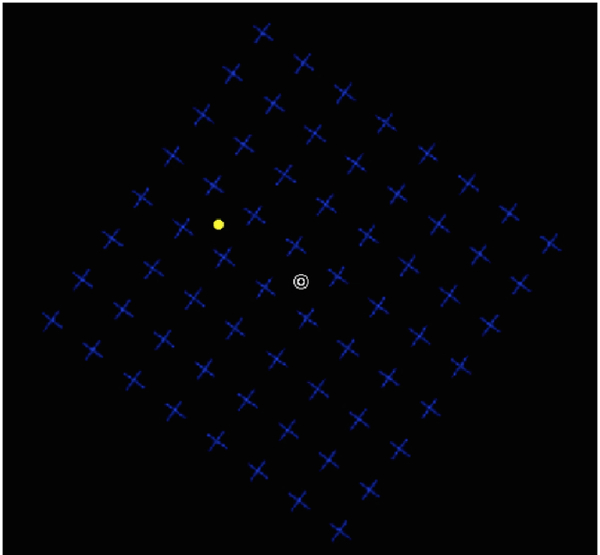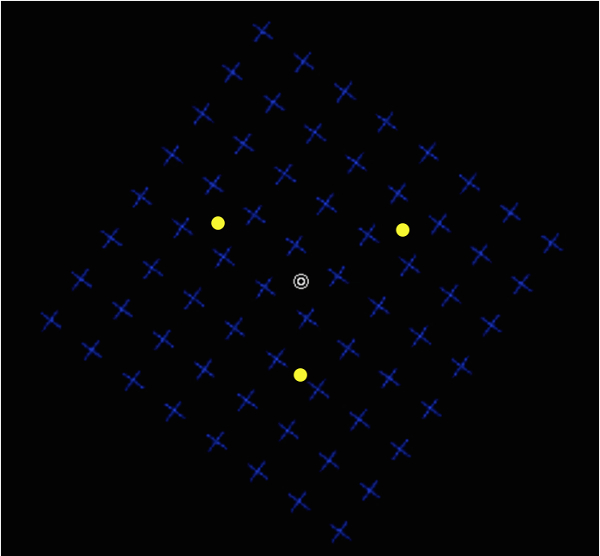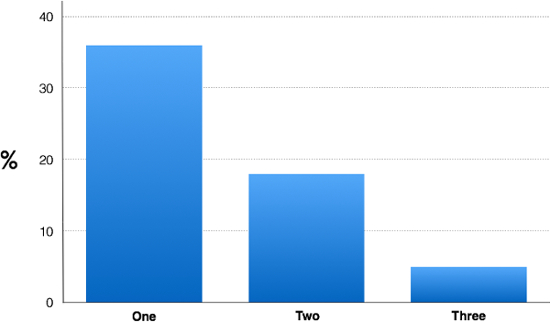Motion-induced Blindness
Przegląd
Source: Laboratory of Jonathan Flombaum—Johns Hopkins University
One thing becomes very salient after basic exposure to the science of visual perception and sensation: what people see is a creation of the brain. As a result people may fail to see things, see things that are not there, or see things in a distorted way.
To distinguish between physical reality and what people perceive, scientists use the term awareness to refer to what people perceive. To study awareness, vision scientists often rely on illusions-misperceptions that can reveal the ways that the brain constructs experience. In 2001, a group of researchers discovered a striking new illusion called motion-induced blindness that has become a powerful tool in the study of visual awareness.1
This video demonstrates typical stimuli and methods used to study awareness with motion-induced blindness.
Procedura
1. Stimulus
- Doing a motion-induced blindness experiment requires software or a programming environment that can make simple animations and collect keypress responses.
- The basic motion-induced blindness stimulus involves three features: a square made up of bright blue crosses on a black background, a bright yellow disc towards one of the corners of the space occupied by the square, and a white disc in the centre of the screen to serve as a fixation point. Figure 1 shows a single frame of basic motion-induced blindness stimulus.
- Set the square of blue crosses to rotate continuously in one direction, as though the square is pegged down by a fixation point.

Figure 1: A single frame containing the motion-induced blindness stimulus. In the dynamic version, the square of blue crosses rotates around the central fixation point, while the yellow dot remains stationary.
2. Producing the illusion
- To experience the illusion, fixate the white disc in the center of the stimulus, but also attend to the yellow disc as you watch the motion of the blue crosses. The yellow disc should disappear from awareness, even though it never actually disappears from the screen.
3. Running an experiment
- To run a basic experiment, create a slightly different version of the stimulus. Rather than the one yellow disc in the upper left corner of the stimulus, include a yellow disc in the right corner and one on the bottom as well, for a total of three yellow discs. Figure 2 shows a single frame from such a stimulus.

Figure 2: A single frame of a simple motion-induced blindness experiment. Participants are asked to report the number of yellow discs absent from their awareness at each moment.
- Instruct a participant to fixate on the center point while attending to the stimulus widely.
- Tell the participant that the experiment will involve 5, 30-s trials. In each trial they should fixate and attend to the stimulus, and they should report when discs disappear from awareness as follows:
- If one disc is absent, hold down the 'J' key. If two are absent, hold down the 'K' key, and if three are absent, hold down the 'L' key. Adjust which keys are held down as discs enter and disappear from awareness. And when all the discs are perceived, be sure to release all the keys.
- The experiment program should record the participant's key presses.
Wyniki
Figure 2 shows typical results from a single observer. The moving blue crosses cause the brain to believe that the yellow discs may not really be there. But the more discs there are, the less the brain seems to trust that intuition. So only one disc is more likely to disappear compared to two or all three.

Figure 3: Percent of time stimuli are absent from awareness. Results are shown from one typical observer. One or more of the discs was absent from awareness nearly 40% of the time, with two or all of the three stimuli (yellow discs) disappearing simultaneously as well, albeit with less frequency.
Wniosek i Podsumowanie
Motion-induced blindness demonstrates that the brain constructs awareness, and that it can decide what to include there or not. But why does this stimulus cause the brain to believe that the yellow discs are not actually there, deleting them from awareness? One of the applications of this relatively new technique emerges from a theory designed to answer that question.
The theory is known as the Perceptual Scotoma theory, proposed in 2008.2 A scotoma is the name for an injury inside the eye, in particular, an insult to retinal tissue. If a piece of the retina is damaged, the observer should in principle see the consequences in their perceptual awareness. They might see an empty space wherever in the visual field the scotoma is. They don't though. In fact, people are usually not aware they have scotomas at all. It's like wearing very dirty glasses. Often, one only realizes the glasses are dirty when they take them off. Why don't smudges and specs of dirt appear in perceptual awareness? Why don't scotomas as well? The answer is that the brain knows that scotomas are possible. And when it believes some stimulus is caused by a scotoma, it discounts it since it thinks it is not part of the outside world. The way it determines that something is a scotoma is if the stimulation is invariant with respect to the rest of the outside world. In motion-induced blindness, there is a clearly rotating surface-the square made up of crosses-but the yellow discs are invariant; for some reason, they don't rotate as they should if they were on the surface. Therefore, the brain concludes that they must not be, and instead, that they must be inside the eye, an aberration, perhaps caused by an injury. The same principle applies to dirt on someone's glasses. The brain notices that the specs of dirt move wherever the head moves, as they should, only if they are attached to the head in some way. So the brain deletes them from awareness, focusing its interests on what it thinks is in the world outside the observer.
This theory and the illusion of motion-induced blindness has made it possible for scientists to study the ways that the brain compensates and creates awareness when a scotoma occurs, when injury produces imperfections and in the human eye.
Odniesienia
- Bonneh, Y. S., Cooperman, A., & Sagi, D. (2001). Motion-induced blindness in normal observers. Nature, 411(6839), 798-801.
- New, J. J., & Scholl, B. J. (2008). "Perceptual Scotomas" A Functional Account of Motion-Induced Blindness. Psychological Science, 19(7), 653-659.
Przejdź do...
Filmy z tej kolekcji:

Now Playing
Motion-induced Blindness
Sensation and Perception
6.9K Wyświetleń

Color Afterimages
Sensation and Perception
11.1K Wyświetleń

Finding Your Blind Spot and Perceptual Filling-in
Sensation and Perception
17.3K Wyświetleń

Perspectives on Sensation and Perception
Sensation and Perception
11.8K Wyświetleń

The Rubber Hand Illusion
Sensation and Perception
18.3K Wyświetleń

The Ames Room
Sensation and Perception
17.4K Wyświetleń

Inattentional Blindness
Sensation and Perception
13.2K Wyświetleń

Spatial Cueing
Sensation and Perception
14.9K Wyświetleń

The Attentional Blink
Sensation and Perception
15.8K Wyświetleń

Crowding
Sensation and Perception
5.7K Wyświetleń

The Inverted-face Effect
Sensation and Perception
15.5K Wyświetleń

The McGurk Effect
Sensation and Perception
16.0K Wyświetleń

Just-noticeable Differences
Sensation and Perception
15.3K Wyświetleń

The Staircase Procedure for Finding a Perceptual Threshold
Sensation and Perception
24.3K Wyświetleń

Object Substitution Masking
Sensation and Perception
6.4K Wyświetleń
Copyright © 2025 MyJoVE Corporation. Wszelkie prawa zastrzeżone